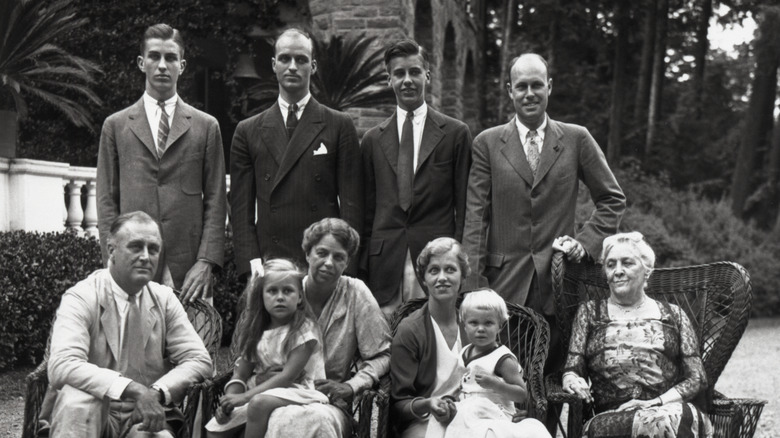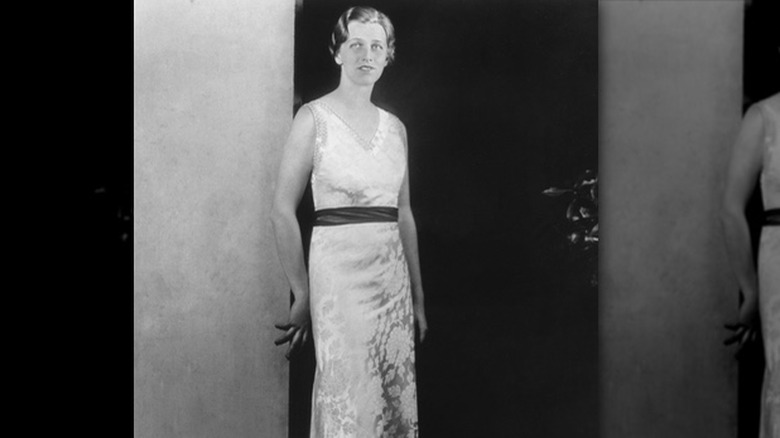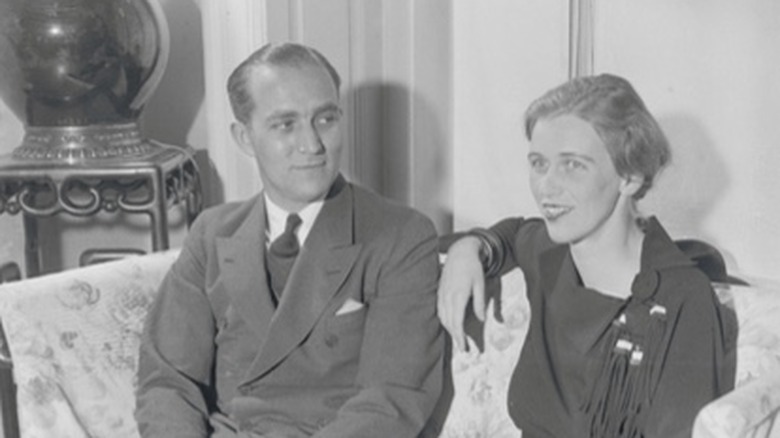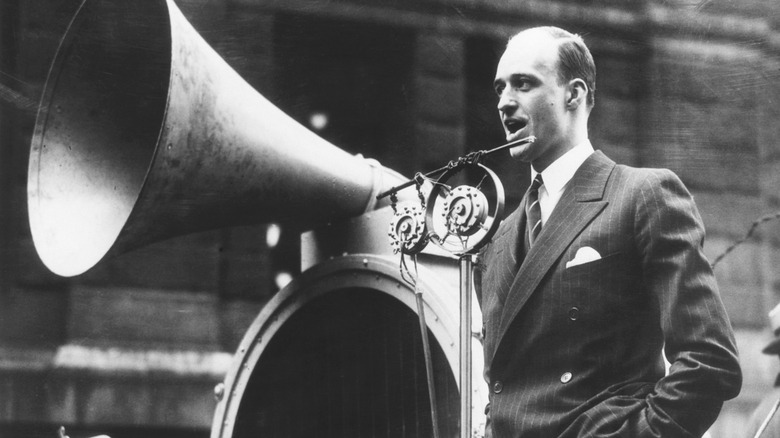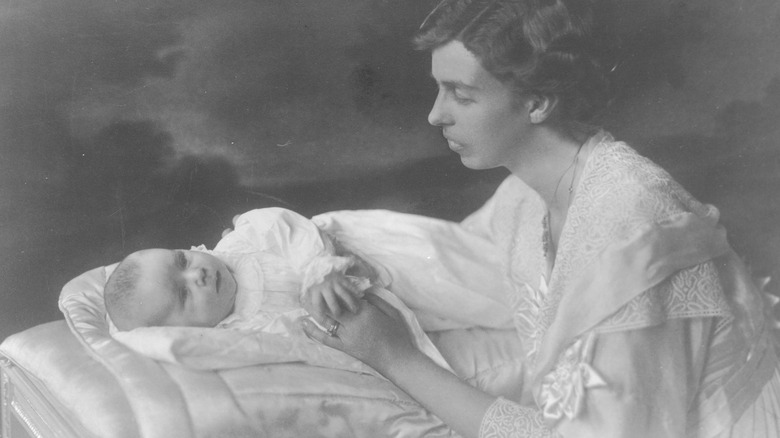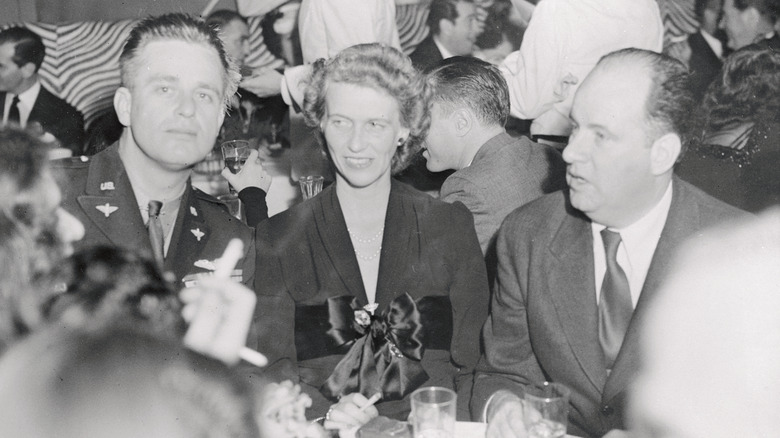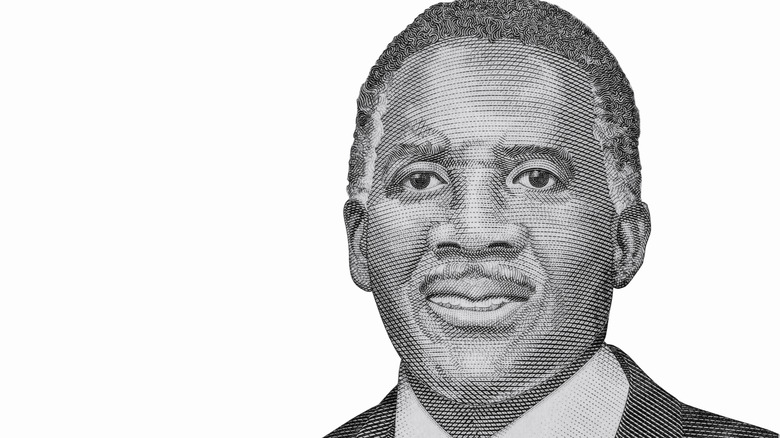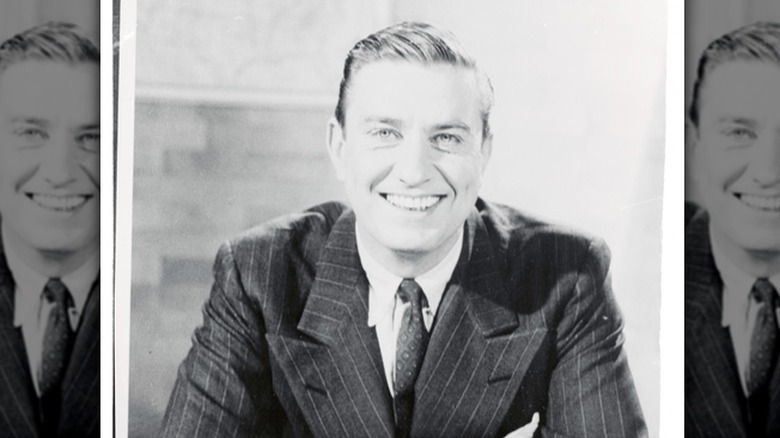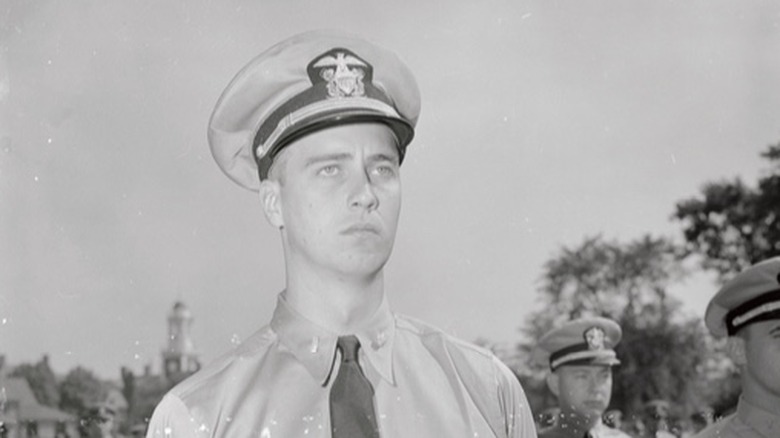What Happened To FDR's Children?
Presidential children are rarely mentioned in the press, unless they deeply involve themselves in the running of an administration or are implicated in scandals or accusations of shady ethics. These children include well-known names such as Hunter Biden, Ivanka Trump, or Chelsea Clinton. Then there are those who stay out completely, like George W. Bush's daughter Jenna Hager — a former teacher who never let her father's office or the press get in the way of her job.
The children of President Franklin Delano Roosevelt — Elliott, Anna, James, Franklin Jr., and John — fit the former mold. Most of them were deeply involved with the Roosevelt administration, and in the case of Elliott, appeared to try and use the president's name to enrich himself in various scandals. Most of them went into politics and philanthropy later in life. But despite their privileged background, the Roosevelt men also proved their mettle on the battlefield during World War II. Here is what they were up to both during their father's tenure and after.
Anna Roosevelt clashed with her mother over duties
Anna Roosevelt was the eldest child and only daughter of President Franklin Roosevelt and his wife Eleanor. In the White House, she acted as de facto first lady and White House hostess. Her mother was too politically active to be bothered with social functions, so Anna served in her stead. Given her role as Roosevelt's social secretary, Anna asked to accompany her father to the 1945 Yalta Conference, where he met with Joseph Stalin and Winston Churchill to decide the fate of post-war Europe. President Roosevelt, who was dying of heart disease, had the option of picking either Eleanor or Anna.
For the president, the decision was easy. His marriage with Eleanor was on the rocks, particularly as rumors swirled about the president's affair with Lucy Mercer Rutherford. Unsurprisingly, FDR did not want Eleanor with him, so he put Anna on the delegation to avoid bringing her mother. At Yalta, Anna's job was to make the ailing president's life as easy as possible, mostly by ensuring that social functions ran smoothly so FDR could focus on his official duties without compromising his health. However, the conference and its aftermath resulted in friction with her mother.
In 1945, President Roosevelt died. Naturally, Anna told her mother of the circumstances of the death, revealing, in what probably stung Eleanor, that FDR had spent his last moments with Lucy. Anna had known about the affair for years, but concealed it from her mother, who took it as a personal betrayal of sorts.
Anna Roosevelt also worked in journalism
Apart from her political role, Anna Roosevelt had a publishing career. After marrying journalist Clarence John Boettiger, she followed him into the business. The couple got their break when newspaper magnate William Randolph Hearst offered them both jobs at the Seattle Post-Intelligencer. Boettiger worked for the Chicago Tribune, whose owner hated FDR. So, he needed a new job. He could not report on FDR while being his son-in-law — a clear conflict of interest. Hearst, meanwhile, was looking to shake up the Post-Intelligencer after a strike had paralyzed it. Interests converged, and Boettiger got the job.
Hearst made Boettiger publisher, giving him a platform to support FDR politically – even when Hearst broke with the president. But the couple was a package deal, meaning Hearst had to give Anna a job, too. He had the perfect one, making her an associate editor in charge of the "women's pages." That chapter of their lives ended when Boettiger signed on with the U.S. military, while Anna returned to the White House.
Following her father's death in 1945, Anna reprised her media career, purchasing an Arizona weekly newspaper alongside her husband. They had turned it into a daily by 1947, and although there was some initial success, the venture failed, leaving the couple indebted. The venture strained the marriage, leading them to separate and eventually divorce in 1949. Her journalistic career ended with the divorce, and her third marriage to James Halsted saw her pivot to non-profits and international organizations. She died in 1975 of cancer.
James Roosevelt II became a Reagan Democrat
James Roosevelt took a series of jobs and military service with the elite "Carlson's Raiders" in the Pacific during World War II, before returning to the United States to pursue a political career in California. In California, James remained a Democrat, but got himself in trouble with the party for supporting Dwight Eisenhower over Harry Truman, defending Richard Nixon, and endorsing Ronald Reagan's 1984 bid. Roosevelt justified his endorsement in the Lodi News-Sentinel, arguing that Reagan was the best choice to continue Franklin Roosevelt's New Deal legacy. But a congressional summons for alleged fraudulent solicitations revealed a break with Reagan.
In 1987, the Los Angeles Times reported that James' PAC, the "National Committee to Preserve Social Security and Medicare," was facing accusations of running a "fund-raising scam that degrade[d] the Roosevelt name" by using scare tactics to solicit donations from the elderly, who depended upon both programs. The PAC argued that both programs risked major solvency crises down the road, and the House Ways and Means Committee summoned James to testify.
The incident revealed a break between James and the Reagan administration's policies. The PAC's executive director, Landis Neal, made it crystal clear that donors to the organization were "frightened by the Reagan administration," presumably a reference to various cuts to social services. Ironically, James had supported Reagan after the president had made Social Security benefits taxable in 1983. The incident appeared to pass without any more fanfare.
The first Franklin Roosevelt Jr. died in infancy
In 1909, the future presidential couple lived in New York City with their two children, Anna and James. That year, Eleanor Roosevelt wrote in her 1937 memoir "This Is My Story" that she gave birth to a third, forgotten Roosevelt child – the first Franklin Roosevelt Jr. – in March of 1909.
Eleanor wrote that this child was "the biggest and most beautiful of all the babies." For the first few months of his life, he was mostly under the care of nurses. He seemed to be doing fine, despite his mother's worries that he would be a difficult child. But in November, he, along with his two siblings, contracted the flu. A doctor's visit confirmed that he had sustained heart damage, and the child died. Eleanor, in her memoir, bewailed not having spent more time with the child, blaming herself for his death. She even wrote that at the funeral, it seemed "cruel" to "leave him out there alone in the cold."
The underlying cause of death turned out to be a heart murmur and endocarditis — inflammation of the inner heart muscle — according to Hazel Rowley's biography "Franklin and Eleanor." The child was buried at St. James' Episcopal Church in Hyde Park, New York. But in December, she found herself pregnant again with another son, Elliott Roosevelt.
Elliott Roosevelt was caught in two airplane scandals
Elliott Roosevelt was known as Franklin Roosevelt's "Black sheep" son – a reputation earned through involvement in various contracting scandals involving aircraft. The first scandal occurred in 1934 and dropped in the press in 1936. The younger Roosevelt had entered into an agreement with Dutch aviation company Fokker to sell military aircraft to the Soviet Union, disguised as civilian planes, through a shell company set up by Elliott Roosevelt. They would split the profits.
A scandal brewed because the plan stank of influence peddling. Elliott had taken the deal knowing that foreign governments would be more open to working with him because he was the president's son. The president objected, but did not stop him. Elliott denied any financial exchange or illegal conduct, noting that the deal collapsed before payment because the Soviets backed out.
The second scandal came in 1943, when Howard Hughes tried to sell the government a XF-II photoreconnaissance airplane. He had the support of Elliott Roosevelt, then a colonel in the Air Corps. The allegation was that the first son had once again put his thumb on the scale in a quid-pro-quo arrangement with Hughes' agent, John Meyer. Meyer wined and dined Elliott, spending over $5,000 for him to meet beautiful women at New York's most exclusive clubs — presumably in return for getting the military to buy Hughes' plane. He even introduced Roosevelt to his future wife, movie star Faye Emerson. Roosevelt denied all wrongdoing, saying he had been abroad when Meyer's records had them meeting.
Elliott Roosevelt was accused of being part of a contract killing
Later in life, Elliott Roosevelt faced a fresh scandal involving an alleged contract killing. On September 18, 1973, Louis Mastriana, a man previously convicted of securities fraud, testified to the Senate that Elliott Roosevelt had been part of an alleged plot to kill the British governor of the Bahamas, Lynden Pindling (pictured above).
The dispute at the center of the alleged plot was straight out of the world of organized crime. Pindling had allegedly reneged on a promise to give a casino license to one Mike McLaney in return for a $1 million donation. This McLaney reportedly had connections to some very dangerous people, including Murder, Inc., honcho Meyer Lansky. Mastriana testified that Elliott Roosevelt offered him $100,000, including $7,500 upfront in cash and a $2,500 check from McLaney to "whack" the Bahamian governor.
Weeks later, The New York Times reported that Roosevelt himself appeared in Washington to refute the charges, calling them "vicious lies" resulting in "emotional, physical and financial stress beyond endurance." He further called Mastriana's claims a hoax and demanded he be prosecuted. The evidence was inconclusive. A check made out to Mastriana was entered into the congressional record, so there was no doubt that Roosevelt had associated with him. But there was no way to determine whether the money was for the alleged hit job, which Mastriana claimed was called off because it would be impossible to escape the Bahamas quickly to cover his tracks.
The second Franklin Roosevelt Jr. was a war hero
The second Franklin Roosevelt Jr. survived infancy and went on to have a distinguished military career, after graduating from Harvard and the Navy ROTC program. When the United States entered World War II in 1941, he signed on to the U.S. Navy. He was posted to Europe, where he was granted no favors as the president's son and cast into the thick of the action. Roosevelt's commission brought him first to North Africa and then to Sicily in 1943. Then, he was a lieutenant on the USS Mayrant, where the crew affectionately called him "Big Pancho." In Sicily, he earned a Silver Star and Purple Heart for heroism during a German air raid against the Sicilian capital, Palermo.
The original military citation (via The Hall of Valor)reads that Roosevelt Jr. was decorated for "conspicuous gallantry and intrepidity in action." German Luftwaffe bombers struck explosive munitions sitting near the docks, causing an explosion and sending shrapnel towards the Maynard. As the bombs continued to fall, the first son rushed to help two wounded crewmates, giving them first aid under fire and carrying them off the ship to safety, saving them.
After Palermo, FDR Jr. was transferred to the Pacific alongside a promotion to lieutenant commander, the USS Moore destroyer to command, and a new nickname – "Big Moose." He saw action in the Philippines, Iwo Jima, and Okinawa, earning another battery of decorations there. After the war, he represented New York in Congress on a third-party ticket and headed the Equal Employment Opportunity Commission under Lyndon Johnson.
John Roosevelt became a Republican
John Roosevelt was FDR's youngest child and a bit of a political maverick. His brothers all held political office: Elliott was mayor of Miami Beach, while Franklin Jr. and James were congressmen and federal bureaucrats in the Democratic Party. John broke with family tradition on both counts.
Unlike his siblings and much to the chagrin of his brother Elliott, John was a Republican, making his party affiliation official in 1947. He also never held political office: The closest he ever came was considering a run for the mayoralty of New York City in 1957. He preferred to support candidates, lending his financial muscle and influence to Ronald Reagan, Dwight Eisenhower, and most annoyingly for his family, Richard Nixon.
John appeared to have maintained close ties to Richard Nixon, who, despite being a Republican, seemed to respect Franklin Roosevelt's New Deal legacy. At least that is what he wrote in a letter (via Christie's) to John, telling him that FDR was a "great president" whose "imprint ... is as often visible today in our newest and most innovative programs as in the many activities first undertaken during his administration." His support for Nixon no doubt caused some strain with his mother, too. Eleanor told NBC she had "no respect" for Nixon, for suggesting during the 1950 Senate campaign that actress Helen Gahagan Douglas was a communist.
